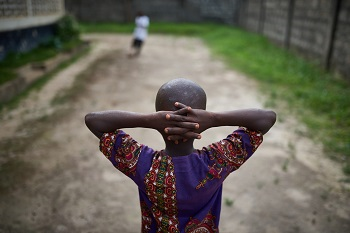West and Central Africa left behind in Global HIV response
New report highlights urgent need for an improved HIV response for children and adolescents
More than four decades into the HIV epidemic, four in five children living with HIV in West and Central Africa are still not receiving life-saving antiretroviral therapy, and AIDS-related deaths among adolescents aged 15-19 are on the rise, according to a new report released on Dec 05.

Boys play football at the HAPPY KIDS and Adolescent NGO in Kenema, Sierra Leone, Sunday 4 June 2017. HAPPY Kids and Adolescents is supported by UNICEF to provide services to children living with HIV and AIDS or those affected by it.
While acknowledging progress in several areas, the report Step Up the Pace: Towards an AIDS-free generation in West and Central Africa, jointly published by UNICEF and UNAIDS, shows that West and Central Africa is lagging behind on nearly every measure of HIV prevention, treatment and care programmes for children and adolescents. In 2016, an estimated 60,000 children were newly infected with HIV in West and Central Africa.
“It is tragic that so many children and adolescents today are not receiving the treatment they need just because they have not been tested,” said Marie-Pierre Poirier, UNICEF’s West and Central Africa Regional Director. “We need to make better use of innovations to increase early diagnosis and improve access to HIV treatment and care for children. For example, the point-of-care technology diagnostic brings testing closer to where children attend health services and self-testing can be a good option for adolescents who may be more comfortable with it.”
The region’s coverage of life-saving antiretroviral therapy among children living with HIV is the lowest in the world because many countries have limited capacity to perform the tests needed for early infant diagnosis of HIV. Without knowing a child’s HIV status, his or her family is less likely to seek the treatment that could prevent the tragedy of a child’s death from AIDS-related illnesses.
The situation is worse among adolescents. The annual number of new HIV infections among those aged 15–19 years in the region now exceeds that of children aged 0-14 years. These new infections occur mostly through unprotected sexual contact and among adolescent girls. Equally concerning, according to the report, is that West and Central Africa has recorded a 35 per cent increase in the annual number of AIDS-related deaths among adolescents aged 15-19 years — the only age group in which the number of AIDS-related deaths increased between 2010 and 2016.
With the region’s youth population expected to grow significantly within the coming decades, especially in countries like the Democratic Republic of the Congo and Nigeria, the numbers of children and adolescents becoming infected with HIV and dying from AIDS is likely to remain high, unless the HIV response – both prevention and treatment – improves dramatically.
The report highlights that the 24 countries that make up the West and Central Africa region are home to 25 per cent of children aged 0–14 years living with HIV worldwide.
“Leaders of the region have endorsed a Catch-Up plan aiming to triple the number of people on treatment in the region – including children – by the end of 2018, the key issue now is to accelerate implementation,” said Luiz Loures, UNAIDS Deputy Executive Director. “Countries should urgently put in place more effective strategies for early infant diagnosis of HIV, and start reducing inequity in children’s access to treatment.”
The report proposes key strategies that will enable countries to accelerate progress in curbing the spread of disease. These include:
1. A differentiated HIV response focusing on unique epidemiological and local contexts in each country and community.
2. The integration of HIV services into key social services including health, education and protection.
3. Community ownership and local governance of the HIV response including working with families, better placed to help reduce stigma, access prevention and treatment.
4. Investment in innovations to remove barriers to scale-up including new diagnostic and biomedical approaches such as point of care diagnostics, HIV self-testing and pre-exposure prophylaxis.
UNICEF announced last week that at the current pace of progress, the global 2020 Super-Fast-Track targets to end AIDS among children will not be achieved.
Source:Untied Nations Chidlren's Fund
- 618 reads
Human Rights
Fostering a More Humane World: The 28th Eurasian Economic Summi

Conscience, Hope, and Action: Keys to Global Peace and Sustainability

Ringing FOWPAL’s Peace Bell for the World:Nobel Peace Prize Laureates’ Visions and Actions

Protecting the World’s Cultural Diversity for a Sustainable Future

Puppet Show I International Friendship Day 2020

